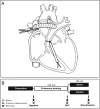A modified Glenn shunt reduces venous congestion during acute right ventricular failure due to pulmonary banding: a randomized experimental study
- PMID: 24396048
- PMCID: PMC3957294
- DOI: 10.1093/icvts/ivt547
A modified Glenn shunt reduces venous congestion during acute right ventricular failure due to pulmonary banding: a randomized experimental study
Abstract
Objectives: Right ventricular failure after left ventricular assist device implantation is a serious complication with high rates of mortality and morbidity. It has been demonstrated in experimental settings that volume exclusion of the right ventricle with a modified Glenn shunt can improve haemodynamics during ischaemic right ventricular failure. However, the concept of a modified Glenn shunt is dependent on a normal pulmonary vascular resistance, which can limit its use in some patients. The aim of this study was to explore the effects of volume exclusion with a modified Glenn shunt during right ventricular failure due to pulmonary banding, and to study the alterations in genetic expression in the right ventricle due to pressure and volume overload.
Methods: Experimental right ventricular failure was induced in pigs (n = 11) through 2 h of pulmonary banding. The pigs were randomized to either treatment with a modified Glenn shunt and pulmonary banding (n = 6) or solely pulmonary banding (n = 5) as a control group. Haemodynamic measurements, blood samples and right ventricular biopsies for genetic analysis were sampled at baseline, at right ventricular failure (i.e. 2 h of pulmonary banding) and 1 h post-right ventricular failure in both groups.
Results: Right atrial pressure increased from 10 mmHg (9.0-12) to 18 mmHg (16-22) (P < 0.01) and the right ventricular pressure from 31 mmHg (26-35) to 57 mmHg (49-61) (P < 0.01) after pulmonary banding. Subsequent treatment with the modified Glenn shunt resulted in a decrease in right atrial pressure to 13 mmHg (11-14) (P = 0.03). In the control group, right atrial pressure was unchanged at 19 mmHg (16-20) (P = 0.18). At right heart failure, there was an up-regulation of genes associated with heart failure, inflammation, angiogenesis, negative regulation of cell death and proliferation.
Conclusions: Volume exclusion with a modified Glenn shunt during right ventricular failure reduced venous congestion compared with the control group. The state of right heart failure was verified through genetic expressional changes.
Keywords: Assisted circulation; Bidirectional Glenn shunt; Microarray analysis; Right-sided heart failure.
Figures



Similar articles
-
A modified Glenn shunt improves haemodynamics in acute right ventricular failure in an experimental model.Eur J Cardiothorac Surg. 2013 Mar;43(3):612-8. doi: 10.1093/ejcts/ezs386. Epub 2012 Jul 3. Eur J Cardiothorac Surg. 2013. PMID: 22761503
-
A modified Glenn shunt reduces right ventricular stroke work during left ventricular assist device therapy.Eur J Cardiothorac Surg. 2016 Mar;49(3):795-801. doi: 10.1093/ejcts/ezv171. Epub 2015 May 16. Eur J Cardiothorac Surg. 2016. PMID: 25983079
-
Distinct loading conditions reveal various patterns of right ventricular adaptation.Am J Physiol Heart Circ Physiol. 2013 Aug 1;305(3):H354-64. doi: 10.1152/ajpheart.00180.2013. Epub 2013 May 31. Am J Physiol Heart Circ Physiol. 2013. PMID: 23729212
-
Bidirectional Cavopulmonary Shunt for Right Ventricular Unloading.Ann Thorac Surg. 2021 May;111(5):1435-1441. doi: 10.1016/j.athoracsur.2020.06.037. Epub 2020 Aug 20. Ann Thorac Surg. 2021. PMID: 32828750 Review.
-
'End-stage' heart failure therapy: potential lessons from congenital heart disease: from pulmonary artery banding and interatrial communication to parallel circulation.Heart. 2017 Feb 15;103(4):262-267. doi: 10.1136/heartjnl-2015-309110. Epub 2016 Dec 23. Heart. 2017. PMID: 28011759 Free PMC article. Review.
Cited by
-
Role and Applications of Experimental Animal Models of Fontan Circulation.J Clin Med. 2024 Apr 29;13(9):2601. doi: 10.3390/jcm13092601. J Clin Med. 2024. PMID: 38731130 Free PMC article. Review.
-
The Role of G Protein-Coupled Receptors in the Right Ventricle in Pulmonary Hypertension.Front Cardiovasc Med. 2018 Dec 17;5:179. doi: 10.3389/fcvm.2018.00179. eCollection 2018. Front Cardiovasc Med. 2018. PMID: 30619886 Free PMC article. Review.
-
Establishment and Hemodynamic Assessment of the Superior Cavopulmonary Anastomosis in a Reproducible Porcine Model.Biomedicines. 2025 Apr 9;13(4):918. doi: 10.3390/biomedicines13040918. Biomedicines. 2025. PMID: 40299509 Free PMC article.
-
Therapeutic challenges and new therapeutic targets for combined capillary pulmonary hypertension: a review.Front Med (Lausanne). 2025 May 2;12:1579112. doi: 10.3389/fmed.2025.1579112. eCollection 2025. Front Med (Lausanne). 2025. PMID: 40385572 Free PMC article. Review.
-
Autologous Umbilical Cord Blood-Derived Mononuclear Cell Therapy Promotes Cardiac Proliferation and Adaptation in a Porcine Model of Right Ventricle Pressure Overload.Cell Transplant. 2022 Jan-Dec;31:9636897221120434. doi: 10.1177/09636897221120434. Cell Transplant. 2022. PMID: 36086821 Free PMC article.
References
-
- Miller LW, Pagani FD, Russell SD, John R, Boyle AJ, Aaronson KD, et al. Use of a continuous-flow device in patients awaiting heart transplantation. New Eng J Med. 2007;357:885–96. doi:10.1056/NEJMoa067758. - DOI - PubMed
-
- Slaughter MS, Rogers JG, Milano CA, Russell SD, Conte JV, Feldman D, et al. Advanced heart failure treated with continuous-flow left ventricular assist device. New Engl J Med. 2009;361:2241–51. doi:10.1056/NEJMoa0909938. - DOI - PubMed
-
- Dang NC, Topkara VK, Mercando M, Kay J, Kruger KH, Aboodi MS, et al. Right heart failure after left ventricular assist device implantation in patients with chronic congestive heart failure. J Heart Lung Transplant. 2006;25:1–6. doi:10.1016/j.healun.2005.07.008. - DOI - PubMed
-
- Deng MC, Edwards LB, Hertz MI, Rowe AW, Keck BM, Kormos R, et al. Mechanical circulatory support device database of the International Society for Heart and Lung Transplantation: third annual report—2005. J Heart Lung Transplant. 2005;24:1182–7. doi:10.1016/j.healun.2005.07.002. - DOI - PubMed
-
- Matthews JC, Koelling TM, Pagani FD, Aaronson KD. The right ventricular failure risk score a pre-operative tool for assessing the risk of right ventricular failure in left ventricular assist device candidates. J Am Coll Cardiol. 2008;51:2163–72. doi:10.1016/j.jacc.2008.03.009. - DOI - PMC - PubMed
Publication types
MeSH terms
LinkOut - more resources
Full Text Sources
Other Literature Sources
Medical
Molecular Biology Databases

